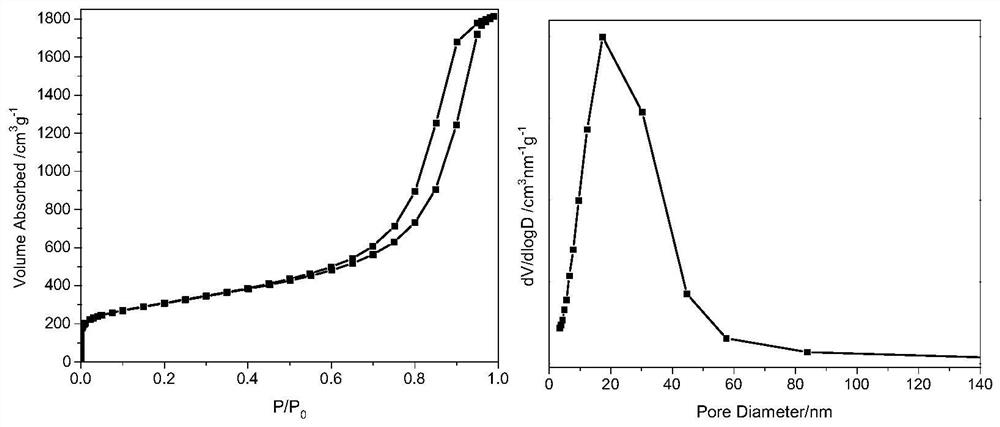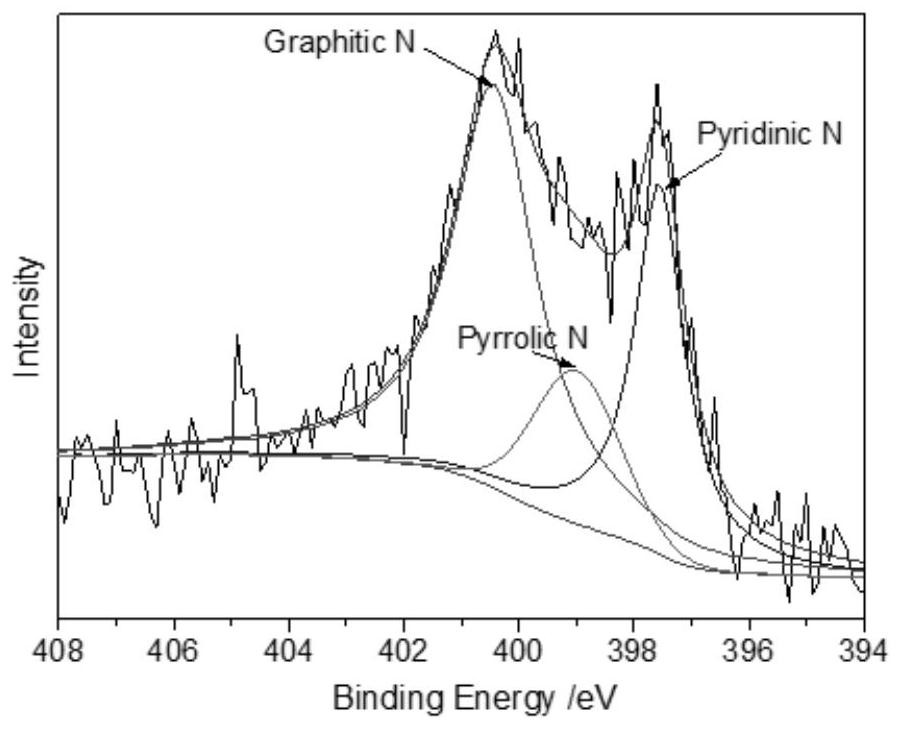A kind of in-situ nitrogen-doped porous carbon material and its preparation method
A nitrogen-doped porous carbon, in-situ technology, applied in the field of materials science, can solve problems such as high toxicity and lengthy procedures
- Summary
- Abstract
- Description
- Claims
- Application Information
AI Technical Summary
Problems solved by technology
Method used
Image
Examples
Embodiment 1
[0034] (1) Precursor preparation: weigh MgCl 2 ·6H 2 O (12.19g, 60mmol) and AlCl 3 ·6H 2 O (19.3g, 40mmol) was dissolved in 150g deionized water to obtain mixed solution I; NaOH (4g, 0.2mol) and NaOH were weighed 2 CO 3 (8.48g, 0.08mol) was dissolved in 150g deionized water to obtain mixed solution II; at room temperature, mixed solution II was slowly added dropwise to mixed solution I, and then added with a mass concentration of 37% formaldehyde solution 22.1g (formaldehyde The molar weight is 0.272mol), resorcinol 15g (0.136mol), after stirring for 2h, adjust the pH value to 10 with sodium hydroxide solution. The stirring temperature was raised to 40°C for 2 hours, then 3.82 g (0.045 mol) of dicyandiamide was added, transferred to a hydrothermal kettle, and the temperature was continued to rise to 80°C for 18 hours of hydrothermal reaction. After the reaction, a gel was obtained, which was placed in an oven, dried at 110° C. for 12 hours, and then ground into powder to ...
Embodiment 2
[0040] (1) Precursor preparation: weigh MgCl 2 ·6H 2 O (12.19g, 60mmol) and AlCl 3 ·6H 2 O (19.3g, 40mmol) was dissolved in 150g deionized water to obtain mixed solution I; NaOH (4g, 0.2mol) and NaOH were weighed 2 CO 3 (8.48g, 0.08mol) was dissolved in 150g deionized water to obtain mixed solution II; at room temperature, mixed solution II was slowly added dropwise to mixed solution I, and then adding mass concentration was 37% formaldehyde aqueous solution 16.57g (formaldehyde The molar weight is 0.204mol), resorcinol 15g (0.136mol), after stirring for 3h, adjust the pH value to 11 with sodium hydroxide solution. The stirring temperature was raised to 50°C for 2 hours, then 3.82 g (0.045 mol) of dicyandiamide was added, transferred to a hydrothermal kettle, and the temperature was continued to rise to 100°C for 18 hours of hydrothermal reaction. After the reaction, a gel was obtained, which was placed in an oven, dried at 100° C. for 48 hours, and then ground into powde...
Embodiment 3
[0046] (1) Precursor preparation: weigh MgCl 2 ·6H 2 O (12.19g, 60mmol) and AlCl 3 ·6H 2 O (19.3g, 40mmol) was dissolved in 150g deionized water to obtain mixed solution I; NaOH (4g, 0.2mol) and NaOH were weighed 2 CO 3 (8.48g, 0.08mol) was dissolved in 150g deionized water to obtain mixed solution II; at room temperature, mixed solution II was slowly added dropwise to mixed solution I, and then added with a mass concentration of 37% formaldehyde solution 22.1g (formaldehyde The molar weight is 0.272mol), resorcinol 15g (0.136mol), after stirring for 2h, adjust the pH value to 10 with sodium hydroxide solution. The stirring temperature was raised to 40°C for 2 hours, then 11.1 g (0.132 mol) of dicyandiamide was added, transferred to a hydrothermal kettle, and the temperature was continued to rise to 80°C for 48 hours of hydrothermal reaction. After the reaction, a gel was obtained, which was placed in an oven, dried at 150° C. for 12 hours, and then ground into powder to ...
PUM
| Property | Measurement | Unit |
|---|---|---|
| specific surface area | aaaaa | aaaaa |
| pore size | aaaaa | aaaaa |
Abstract
Description
Claims
Application Information
 Login to View More
Login to View More - R&D
- Intellectual Property
- Life Sciences
- Materials
- Tech Scout
- Unparalleled Data Quality
- Higher Quality Content
- 60% Fewer Hallucinations
Browse by: Latest US Patents, China's latest patents, Technical Efficacy Thesaurus, Application Domain, Technology Topic, Popular Technical Reports.
© 2025 PatSnap. All rights reserved.Legal|Privacy policy|Modern Slavery Act Transparency Statement|Sitemap|About US| Contact US: help@patsnap.com



